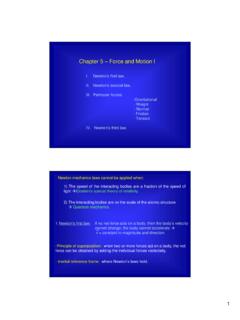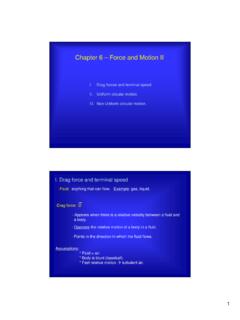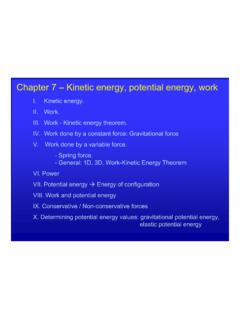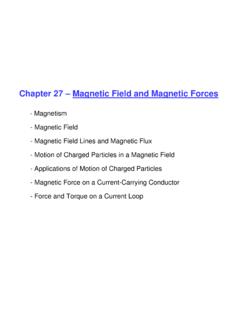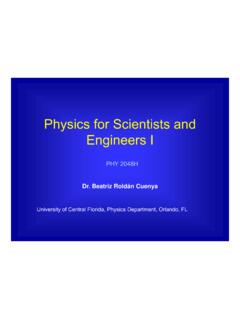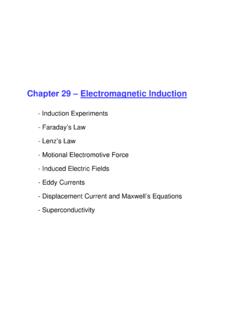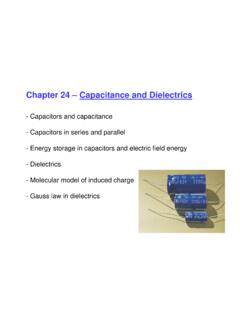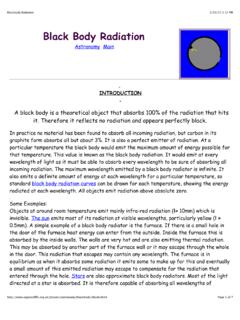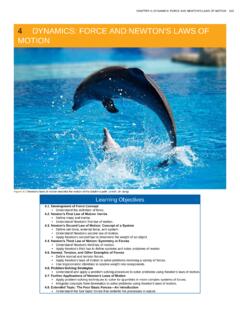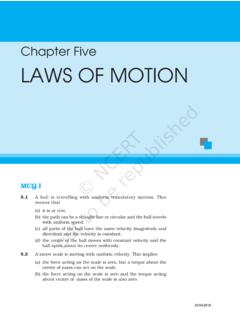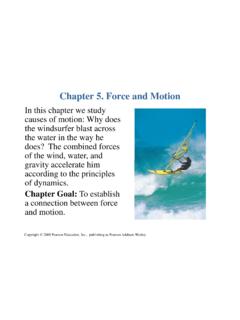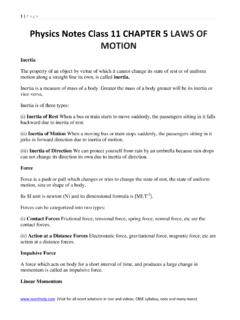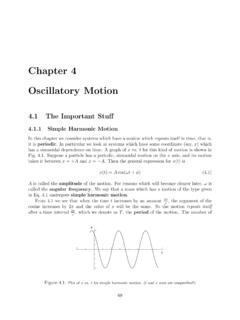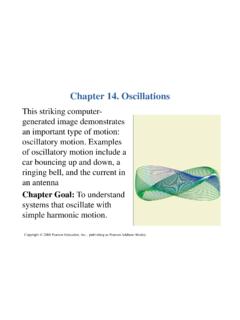Transcription of Chapter 5 – Force and Motion I - Physics
1 S first Newton s second Particular forces:-Gravitational- Weight-Normal -Friction- TensionIV. Newton s third 5 Force and Motion II. Newton s first law: If no net forceacts on a body, then the body s velocitycannot change; the body cannot accelerate v = constant in magnitude and Principle of superposition:when two or more forces act on a body, the netforce can be obtained by adding the individual forces mechanics laws cannot be applied when:1) The speed of the interacting bodies are a fraction of the speed oflight Einstein s special theory of ) The interacting bodies are on the scale of the atomic structure Quantum mechanics- Inertial reference frame: where Newton s laws Newton s second law: The net Force on a body is equal to the product of the body s mass and its acceleration.
2 (amFnet ) (,,,,,zznetyynetxxnetmaFmaFmaF - The acceleration component along a given axis is caused only by the sum of the Force components along the same axis, and not by Force componentsalong any other axis. - System: collection of bodies. - External Force :any Force on the bodies inside the Particular forces:-Gravitational:pull directed towards a second body, normally the Earth ) (gmFg ) (mgW - Weight:magnitude of the upward Force needed to balance the gravitationalforce on the body due to an astronomical body ) (mgN - Normal Force :perpendicular Force on a body from a surface against whichthe body Frictional Force : Force on a body when the bodyattempts to slide along a surface.)
3 It is parallelto the surface and opposite to the :pull on a body directed away from thebody along a massless Newton s third law: When two bodies interact, the forces on the bodiesfrom each other are always equal in magnitude and opposite in direction.) (CBBCFF horizontal forces F1,F2pull a banana split across a frictionless using a calculator, determine which of the vectors in the free body diagrambelow best represent: a) F1,b)F2. What is the net Force component along (c) thex-axis, (d) the y-axis? Into which quadrant do (e) the net- Force vector and (f) thesplit s acceleration vector point?
4 JNiNFjNiNF )2( )1( )4( )3(21 jNiNFFFnet )6( )2(21 Same quadrant, 4F1F2I. Frictional Force -Kinetic: (fk) appears after a large enough external Force is applied and the body loses its intimate contact with the surface, sliding along motionAccelerationConstant velocityCounter Force that appears when an external Force tends to slide a body along a surface. It is directed parallel to the surface and opposite to the sliding (appliedforce)//Ffs -Static:(fs) compensates the applied Force , the body doesnot ,skff ) (max,Nfss ) (Nfkk Friction coefficientsslidesbodyfFIfs max,//After the body starts sliding, figure below shows overhead views of four situations in which forces acton a block that lies on a frictionless floor.
5 If the Force magnitudes are chosenproperly, in which situation it is possible that the block is (a) stationary and(b) moving with constant velocity?ay 0a=0ay 0a= which situations does theobject acceleration have (a) anx-component, (b) a y component?(c) give the direction of body suspended by a rope has a weigh of 75N. Is T equal to, greater than,or less than 75N when the body is moving downward at (a) increasing speed and(b) decreasing speed?Fg)(agmTamTFFgnet Movement(a) Increasing speed:vf>v0 a>0 T< Fg(b) Decreasing speed: vf< v0 a<0 T> figure below shows a train of four blocks being pulledacross a frictionless floor by Force F.
6 What total mass isaccelerated to the right by (a) F, (b) cord 3 (c) cord 1? (d) Rank theblocks according to their accelerations, greatest first. (e) Rank thecords according to their tension, greatest (a) F pulls mtotal= (10+3+5+2)kg = 20kg(b) Cord 3 T3 m=(10+3+5)kg = 18kg(c) Cord 1 T1 m= 10kg(d) F=ma All tie, same acceleration(e) F-T3=2aT3-T2=5aT2-T1=3aT1=10aF-T3=2a F=18a+2a=20aT3-13a= 5a T3=18aT2-10a=3a T2=13aT1= toy box is on top of a heavier dog house, which sits on a wood floor. Theseobjects are represented by dots at the corresponding heights, and six verticalvectors (not to scale) are shown.
7 Which of the vectors best represents (a) thegravitational Force on the dog house, (b) on the toy box, (c) the Force on the toy boxfrom the dog house, (d) the Force on the dog house from the toy box, (e) Force on thedog house from the floor, (f) the Force on the floor from the dog house? (g) Which ofthe forces are equal in magnitude? Which are (h) greatest and (i) least inmagnitude?(a) Fgon dog house:4or 5(c) Ftoyfrom dog house: 1(b) Fgon toy box: 2(d) Fdog-housefrom toy box: 4 or5(e) Fdog-housefrom floor: 3(f) Ffloorfrom dog house: 6(g) Equal: 1=2, 1=5, 3=6(h) Greatest: 6,3(i) Smallest: 1,2, are two forces on the 2 kg box in the overhead view of the figure belowbut only one is shown.
8 The figure also shows the acceleration of the box. Find thesecond Force (a) in unit-vector notation and as (b) magnitude and (c) direction. ) 32( 20) 12(/) 6(2/) 6(/) 240sin12 240cos12(2222222221222 orNFNjiFFNFNFNFNFFiFFFN jismjikgamFsmjismjiayTyxxTxTT F2 Rules to solve Dynamic problems- Select a reference Make a drawing of the particle Isolate the particles within the Draw the forces that act on each of the isolated Find the components of the forces Apply Newton s second law (F=ma) to each isolated (a) A 11kg salami is supported by a cord that runs to a spring scale, which issupported by another cord from the ceiling.
9 What is the reading on the scale, which ismarked in weigh units? (b) Here the salami is supported by a cord that runs around apulley and to a scale. The opposite end of the scale is attached by a cord to a is the reading on the scale? (c) The wall has been replaced by a second salamion the left, and the assembly is stationary. What is the reading on the scale now? )( ) )(11(2 )( )( In all three cases the scale is not accelerating, which means that the twocords exert forces of equal magnitude on it. The scale reads themagnitude of either of these forces. In each case the tension Force ofthe cord attached to the salami must be the same in magnitude as theweigh of the salami because the salami is not electron with a speed of moves horizontally into a region where aconstant vertical Force of acts on it.
10 The mass of the electron ism= Determine the vertical distance the electron is deflected during thetime it has moved 30 mm ) ( dx= ) () ( 2143123116 ) () )( ( the figure below, mblock= and =30 . Find (a) Tension in the cord.(b) Normal Force acting on the block. (c) If the cord is cut, find the magnitudeof the block s )(smaaNmaFTcgx ) )( (30sin000)(2 )( figure below gives as a function of time t, the Force component Fxthatactsona3kgiceblock,which can move only along the x axis. At t=0, the block is moving in the positive direction of the axis, witha speed of 3m/s.
